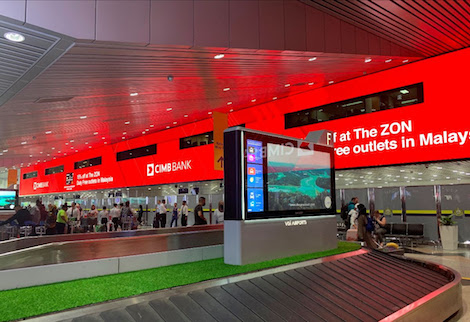When Kuala Lumpur International Airport’s operating company, Malaysian Airport Holding Berhad (MAHB), decided that the country’s aviation hub was in need of a serious visual update, local media company VGI Airports, part of VGI Malaysia was their first port of call.
Nacho Perez, chief digital officer at VGI Malaysia said “For many years, VGI Airports has been the advertising concessionaire for KLIA. When the time came for the airport to upgrade, they decided to use the opportunity to develop a brand-new digital advertising platform. My role during this process was to lead digital development. Including selecting the locations to be newly installed or upgraded, identifying the right technology and suppliers for the installation of the screens, and also taking care of maintenance, and content delivery, creation, and scheduling.”
Located 34 miles outside of Kuala Lumpur, the international airport spans an incredible 100 km², and is one of the busiest airports in the world, with 62.3 million passengers in 2019. KLIA was designed and built as part of the MSC Malaysia plan – to create a high-technology business district in Selangor, Malaysia. Each phase of the KLIA project expanded the airport and boosted passenger numbers, with phase three, the final phase, designed to bring in over 100 million passengers, and continuing to make the airport the largest and busiest in Malaysia.
After an exhaustive planning phase, the team decided that a digital overhaul was required throughout the airport; following the flow of passengers from the drop off area, through the check-in hall, immigration, and departures gates. A similar flow was needed in the opposite direction, from the arrival gates, through immigration corridors to the baggage carousels and, ultimately, the arrivals hall.
Nacho Perez continued “From the outset, it was clear that digital was the only way to move forward. It allows flexibility and precision, in order to display the relevant advertisements and messages to the right audience at the right time, using the right content. We only work with the best suppliers for every technology,” he said. “That means selecting each supplier based on a combination of quality, reliability, support, and total cost of ownership. Absen’s LED technology ticked every box for us and their customer service was second to none throughout.”
VGI decided to use a combination of LCD and LED technology, depending on the size of the screens and the idiosyncrasies of each location, and Perez’s primary choice for the latter was always going to be Absen.
VGI Airports selected a combination of Absen N4, Acclaim A2719, and A2725 for the installation, split into three different areas. In the arrivals area, Absen’s N4 created the ‘Digital Dream’ screen, an impressive 400sqm LED wall that boasts a jaw dropping 23,976W x 1,008H resolution. Absen’s A2719 was selected for the Satellite Digital Impact Network screen to cover both arrival and departures of international destinations. The same product was also used for full HD displays at check in area, while the Digital Arrivals Impact Network screen features a curved 7.3m x 2m (12 x 6 panels) A2725 LED wall strategically installed above the escalators for new arrivals.
Absen’s N series and Acclaim series are designed for permanent indoor display, and are perfect for use in a busy corporate, transport or retail space. At a slim two-inch panel depth, with a 1000 nit brightness and 8.8kg weight, the N4 boasts a vivid, lightweight display for all indoor requirements. With wide viewing angles and remote tracking, in which real time performance tracking can be sent and viewed from a mobile, the N4 leant itself flawlessly to the airport’s requirements, while still presenting the sharp colour and brightness uniformity associated with Absen’s range of products.
Ruben Rengel, Absen’s senior vice-president of global business development told us “At Absen, we’ve always been committed to offering the best solutions no matter the customer, and in a critical environment such as this, quality, reliability and simple install products are key aspects to the correct solution,” said The N series, along with the Acclaim series, answered those requirements flawlessly, and the outcome of the hard work from the Absen and VGI teams was an incredible display.”
The installation itself began in March 2019 and was completed by February 2020, just in time to miss the disruption caused by #Covid19. Although footfall has fluctuated drastically in the intervening months, the airport’s administrators and (perhaps more importantly) travellers have had plenty of time to marvel at its new look.
Picture courtesy of VGI Malaysia


Follow DailyDOOH